
There are some startups and SMEs hosting their databases on AWS. However, most of them choose to use Amazon EC2 because doing so is similar to running a SQL Server on-premise at data centres. So, to them, it’s something that they are familiar with back in the old days. However, doing so actually increases their cost of hosting services on AWS. The companies also need to hire experts to do database administration such as database backup and recovery and OS patching.
Hence, if I’m given the opportunity, I usually recommend the small companies with limited resources to consider Amazon RDS (or Azure SQL) first. Amazon RDS is a fully managed service which provides cost-efficient and resizable capacity while automating time-consuming database administration tasks.
Multi-AZ Deployments for MS SQL Server
Starting from May 2014, Amazon RDS also provides a highly available database solution with the synchronous Multi-AZ replication for MS SQL. Multi-AZ deployments for MS SQL database instances use SQL Server Mirroring.
Currently, Amazon RDS only supports Standard Edition and Enterprise Edition of SQL Server 2008 R2, 2012, 2014, and 2016. Amazon RDS also does not support Multi-AZ with Mirroring for the following regions yet:
- US West (N. California);
- Asia Pacific (Singapore);
- European Union (Frankfurt);
- AWS GovCloud (US);
- Asia Pacific (Sdyney): Supported for DB instances in VPCs only;
- Asia Pacific (Tokyo): Supported for DB instances in VPCs only;
- South America (São Paulo): Supported for all DB instance classes except m1/m2.
It’s quite unfortunate that Singapore Region is one of them.

DB Instance Class
We can specify the DB Instance Class that allocates the computational, network, and memory capacity required by planned workload of the database instance.
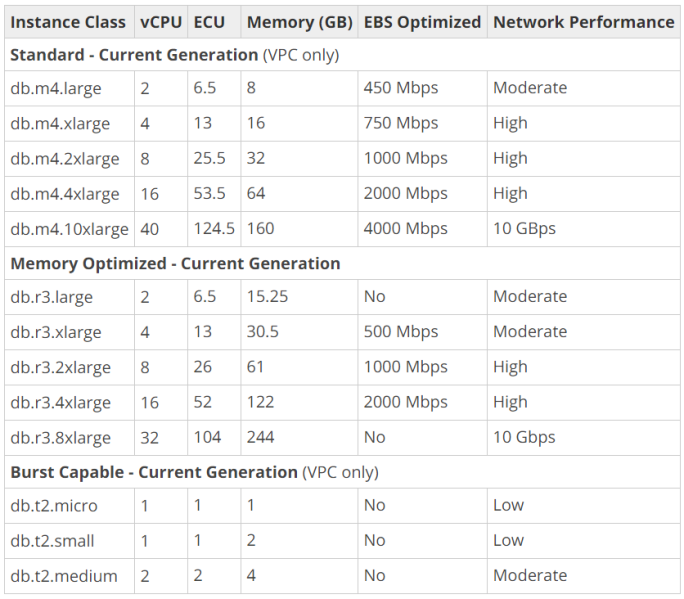
Standard (db.m4) instances offer a balance of compute, memory, and network resources, and are a good choice for many applications.
Memory Optimized (db.r3) instances are designed to deliver fast performance for workloads that process large data sets in memory. The instances are well suited for the applications, such as high performance relational databases, in-memory analytics, and enterprise applications (for example, Microsoft SharePoint).
Burst Capable (db.t2) instances are instances that provide baseline performance level with the ability to burst to full CPU usage.
Storage Types
Most of the Amazon RDS are using Amazon EBS (Elastic Block Store) volumes for database and log storage. There are currently two main Storage Types available when setting up MS SQL database instances, as listed below.
General Purpose (SSD) storage, aka gp2, offers cost-effective storage which is suitable for a broad range of database workloads. Hence, it’s ideal for small to medium-sized databases. It provides baseline of 3 IOPS/GB and ability to burst to 3,000 IOPS for extended periods of time. Its volume can range from 20GB to 4TB for MS SQL database instances. However, provisioning less than 100 GB of General Purpose (SSD) storage for high throughput workloads could result in higher latencies upon exhaustion of the initial General Purpose (SSD) I/O Credit balance.
Provisioned IOPS (SSD) storage, aka io1, is suitable for I/O intensive database workloads which pay attention to storage performance and consistency in random access I/O throughput. It provides flexibility to provision I/O ranging from 1,000 to 30,000 IOPS. MS SQL can have provisioned IOPS volumes between 100GB (Express/Web edition) or 200GB (Standard/Enterprise edition) and 4TB.

Allocated Storage and I/O Credits
General Purpose (SSD) storage performance is controlled by the volume size. Larger volumes have higher base performance levels and can accumulate I/O Credits faster. The more storage, the greater the base performance is and the faster it replenishes the credit balance.
For General Purpose (SSD) storage, the DB instance has an initial I/O Credits balance of 5.4 million. When the storage requires more than the base performance I/O level, it uses I/O credits in the credit balance to burst to the required performance level, up to a maximum of 3,000 IOPS. If the storage uses all of its I/O credit balance, its maximum performance will remain at the base performance level until I/O demand drops below the base level and unused credits are added to the I/O credit balance at the baseline performance rate of 3 IOPS/GB of volume size. Hence, we can use the formula below to calculate the Burst Duration.


Thus, for production application that requires fast and consistent I/O performance, it’s recommended to use Provisioned IOPS (SSD) storage that is optimized for I/O intensive, online transaction processing workloads that have consistent performance requirements. Note that we cannot decrease storage allocated for a DB instance.
For MS SQL Server, Amazon RDS does not currently support increasing storage. Hence, we need to provision storage based on anticipated future storage growth. If we predict it wrongly, then we need to increase the storage of an existing SQL Server DB instance by first exporting the data, creating a new database instance with increased storage, and then importing the data into the new database instance.
Specifying Database Instance Specification
After understanding key concepts above, we can then proceed to setup our database instance.
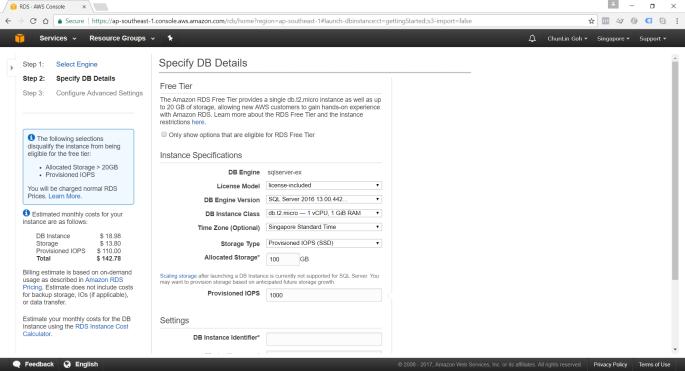
Network and Security: VPC (Virtual Private Cloud)
Amazon RDS database instances can be hosted on either EC2-VPC platform or the legacy EC2-Classic platform, the original platform used by Amazon RDS. Amazon VPC launches AWS resources, such as database instances, into a virtual private cloud.
Nowadays, if we are creating a database instance in a region that we have not used before, we normally are already on the EC2-VPC platform.

There are many scenarios for accessing a database instance in a VPC. Today, I will only focus on having an EC2 web server to access the database instance in the same VPC.
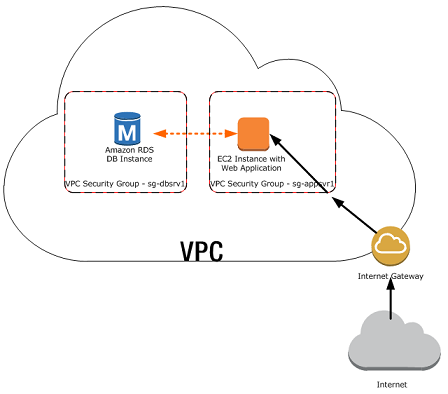
In such scenario, Amazon RDS database instance normally needs to be available to the web server, and not to the public Internet. Hence, we can create a VPC with both public and private subnets. The web server will be hosted in the public subnet so that it is accessible by the public. The database instance is hosted in the private subnet so that it won’t be available to the public Internet, providing greater security.
The Security Group used to restrict access to the database instances can have a custom rule that allows TCP access using the port 1433 and an IP address we will use to access the database instance for development or other purposes. In addition, we also need to set the Public Accessible option to Yes first (It is recommended to set the option to No for production database instance to limit the potential thread with no public routes).
Encryption of Database Instances using Key Management Service (KMS)
Amazon RDS for MS SQL supports the encryption of database instances with encryption keys managed in AWS KMS. Once the data is encrypted, Amazon RDS handles authentication of access and decryption of the data transparently without having the need to change our database client applications.
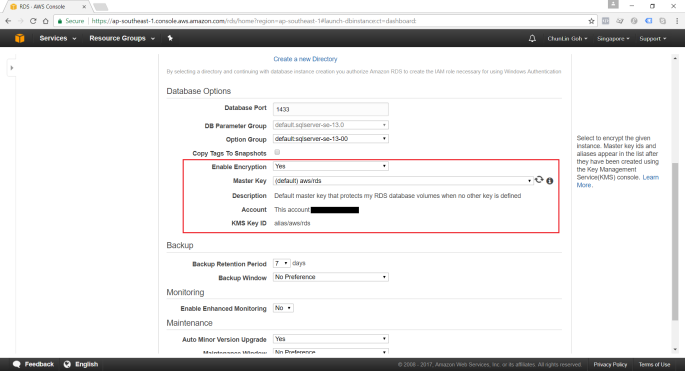
Backup and Maintenance
Amazon RDS automatically backup our database instances. It creates a storage volume snapshot of our database instance, backing up the entire database instance and not just individual databases. We can setup and modify our preferred Backup Window from time to time. During the automatic backup window, storage I/O might be suspended briefly while the backup process initializes (typically under a few seconds). For SQL Server, I/O activity is suspended briefly during backup for Multi-AZ deployments.
By default, Amazon RDS has a 30-minute backup window randomly selected from an 8-hour block (Singapore region will be 14:00–22:00 UTC).
Periodically, Amazon RDS also automatically does maintenance work such as, updating the databse instance’s or database cluster’s OS. We can choose to manually apply maintenance, or wait for the automatic maintenance process initiated during our preferred maintenance window. There is one thing to take note is that the maintenance window determines when pending operations start, but does not limit the total execution time of these operations.
By default, Amazon RDS also has a 30-minute maintenance window randomly selected from an 8-hour block (Singapore region will be 14:00–22:00 UTC).
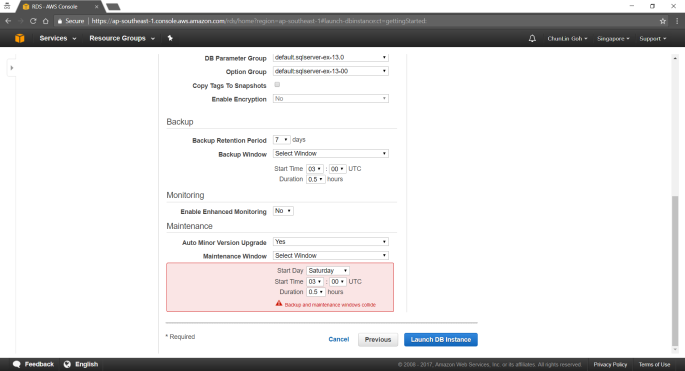
CloudWatch
Amazon RDS sends metrics to CloudWatch for each active database instance every minute. Detailed monitoring is enabled by default.

When setting up the database instance, there is an option for us to specify whether to enable Enhanced Monitoring or not. Enhanced Monitoring is not exactly like CloudWatch. CloudWatch gathers metrics about CPU utilization from the hypervisor for a database instance, and Enhanced Monitoring gathers its metrics from an agent on the instance.

Conclusion
It’s true that AWS allows us to deploy our MS SQL Server database on either Amazon RDS and Amazon EC2. However, it’s very crucial to analyze our needs and our application before deciding which one to use. In general, it is still recommended to consider Amazon RDS first so that developers can focus on high-level tasks and business logic implementation.
That’s all for my first trip to Amazon RDS. As a frequent user of Microsoft Azure, I never host MS SQL Server on AWS platform. So, if there is any mistake made in this article, kindly feedback to me. Thanks in advance!
Base on my years of experience using AWS to help start-up growing their business backbone, I would highly recommend new startup to start with configuring a VPC.
This will save a huge amount of time in the later stages when realizing a managed network is required for compliance/regulation/security. Migrating/re-configuring all the instance from the default VPC to a new VPC is a painful process.
Agree on that. Thanks for highlighting that because if VPC is not correctly setup in the first place, doing it later on production with live data and business, it’s headache to do it.
We found today it seems you can adjust the allocated space to MS SQL server on the fly without backing up and restoring. Not sure when that changed but going to give it a try.
Confirmed you can now resize the allocated disk for SQL Server.